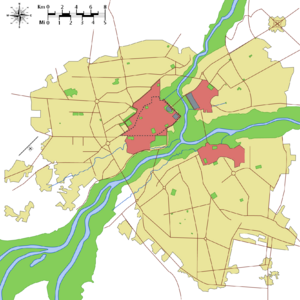Samadar
Samadar
. SAMADAR . | |
|---|---|
Metropolis | |
 Clockwise from top: View of Samadar's historical centre, Khadaz Financial District, Khashawan Palace, Statue of Ashar, Nadjakhar square, Hadjamak Botanical gardens. | |
| Nickname(s): | |
 | |
| Country | |
| State | |
| Province | |
| Earliest settlement | c. 300 BCE |
| Government | |
| • Mayor | Satar Khamanli |
| Area | |
| • Total | 2,300.61 km2 (888.27 sq mi) |
| Elevation | 800 m (2,600 ft) |
| Population (2016 census) | |
| • Total | 5,823,399 |
| • Density | 4,850.36/km2 (12,562.4/sq mi) |
| Demonym(s) | Samadari |
| Time zone | SCT+3 |
| Website | www.Samadar.km |
Samadar (Koman: Samadar) also known as Masandar or Samazar is one of the historical capitals of the Great Horde and officially recognised as the cultural centre of Komania. Samadar is the official capital of the Imperial States and forms part of the Saraj Federal State (SFS), serving as the main legislative and judicial centre for the entire federation. It is located in northwestern Komania with around 5.8 million people. The city is strategically located in a fertile valley which has served as the refuge for many cultures and civilisations throughout history. Situated on a plateau of around 800 metres above sea level, the city is 500 km west of Shanvan. Furthermore, the city is part of Komania's city and transportation network 'Three Sisters', together with Shanvan, and Shahdar.
The city is renowned for its regional architecture, showcasing buildings and districts with styles from various areas of Vaniua, mainly attributed to the cosmopolitan culture of the Great Horde and later architectural trends of the Imperial State. Furthermore, the city has maintained many of its Ashar-era characteristics, making it a prominent destination for tourism.
In 2019, a government-led program was developed twinning the STEM-leading city of Afąván, in Lenezan with Samadar, allowing for academic, and economic collaboration between both cities, including the establishment of FDI incentives.
Etymology
History
The exact date for the establishment of the first settlements in Samadar is unknown, however, excavations in the area pinpoint an increment of human activity around 4000 BCE. Thanks to its strategic position in the Şəhmara valley the area offers largely defensible channels while covering a moderately fertile area. Excavations in the present-day Husah quarter have yielded a wealth of archeological evidence, among the most significant finds are pottery shards, bronze tools, and other artifacts that suggest the city was a center of trade and commerce, even as early as pre-Mamikian times.
Research in the 1960s has suggested a possible link between early settlers and the Sasna Culture of northern Vaniua, shedding light on possible migratory patterns between the proto-Vaniuan peoples of the basin and those living on the northern plains. Despite the amount of evidence, however, early settlements in the area appear to have been seasonal, indicating that early settlers were likely seasonal nomads. This rules in contrast with archeological findings on the coast of the Melkanchuta Sea, where remains from 2000 BCE and onwards seem to have been sedentary in nature. The drier Ghiro plains surrounding the basin present substantial evidence for transitional cultures, in which differences in pottery material might represent a cultural split between the more nomadic proto-Vaniuans and the more sedentary coastal cultures found around the Melkanchuta Sea.
Antiquity
Capital of the Baysanid Khanate
The present-day Husah quarter of Samadar once belonged to a larger network of Ohanian trading outposts and served as a major hub for merchants before the 3rd century CE. The area was subsequently appropriated by the Mishars, who used the remaining settlement and its location to their favour. By the 4th century, Samadar (then known as Masatar) had become the largest city in the region, serving as the capital of the historical Baysanid Khanate, presenting itself as a prominent administrative centre. The Baysanids further consolidated their rule by repurposing a strategically placed Ohanian outpost on the left bank of the Baykheshur river, establishing a complex of palaces, now part of the Asharid Khashawan Palace.
During this period the urban development of Samadar mainly remained confined to the modern-day Husah quarter. The location of the settlement and its direct access to major trading routes made it an excellent administrative centre,
Kothlenic era
Rise of the Qomandi
Asharid era
Warring period and Koman state eras
Districts
Financial district
Historical district
Imperial Quarter
Federal Quarter
The Federal Quarter, comprising the headquarters and federal establishments of Tamiran, is partly located within the Imperial Citadel, formally part of the Historical District of Samadar, it includes the Palace of the Federation, which was historically used as a prominent eastern wing of the Khashawan Palace, former residence of Great Horde emperors and rulers of the Samadar Mizarate. This palace section was repurposed in 1987 shortly after the establishment of Tamiran, whereas Samadar was chosen as the indicated city to become the executive centre of the newly born federation. Restoration of the palace followed strict architectural protocols of the 80s, respecting the integrity of the building and any historical markers noted in its architecture, prominently, using original material from its construction back in the 1400s by importing red stone from Baghazan and ceramic tiles from Vogia. Only 20% to 40% of its interior was demolished and redone for logistical and practical purposes, this included the main hall and the upper floors, which exhibit Classical Hozaran architecture, and where strong classical Ohanian influences can be observed. The Palace of the Federation currently holds the Grand Assembly, whilst the State Council and the Federal Commission building are located separately from the main palace, outside the Historic District.
The Tamiran Tower, officially used as the administrative and executive building of the federal government, lies just outside the Historical District, in an area presently known as the Tamiran Public Estate. Directly adjoining the Khashawan Palace, the tower hosts ministerial offices for the executive branch of the Tamiran Government, the area surrounding the tower also includes the State Council buildings and Federal Commission building. The area and its edifices portray modern neo-traditional architecture and make use of Ohanian and Asharid elements commonly used in the region.
As per the 2007 language clause presented during a revision of the Tamiran constitution, all street signs inside the Federal Quarter have been redone to include Aramani.

